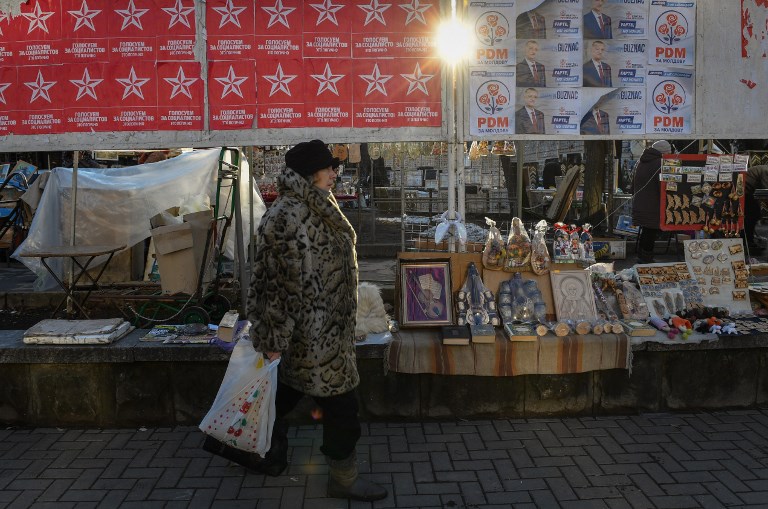English-Français
អន្តរជាតិ

A woman passes handicraft items on sale at an outdoor market next to election posters in Chisinau on February 13, 2019
×![]()
ដោយ: AFP
Chisinau, Moldova The ex-Soviet country of Moldova, which holds parliamentary elections on Sunday, is landlocked and sandwiched between EU member Romania, with which it shares a common language, and Ukraine.
One of Europe's least visited countries, attractions include vineyards and Orthodox monasteries. The country's frozen conflict over the mainly Russian-speaking Transnistria breakaway region is one of the key political issues.
- Between Russia and Europe -
Moldovan president Igor Dodon, who is a figurehead leader, takes a pro-Moscow position while some members of the current government want integration into the European Union, with which the country has signed an Association Agreement.
That duality reflects the country's complex history. It was part of the Ottoman Empire for centuries, then under Russian rule and then part of Romania before becoming the Soviet republic of Moldavia in 1940. It became independent from the USSR in 1991 and was renamed Moldova.
The country's main language is Romanian. Russian is also quite widely spoken and many Moldovans work in Russia. The Russian interior ministry said that more than 400,000 Moldovans entered the country last year. The minority Turkish population speak the Gagauz language, listed as endangered by UNESCO.
- One of Europe's poorest countries -
Moldova is often called Europe's poorest country, but according to the latest ranking of the International Monetary Fund (IMF), it was overtaken by Ukraine in 2018. According to the World Bank, Moldova had a GDP per capita in 2018 of $2,692 -- four times smaller than in neighbouring Romania.
The economy is propped up by remittances sent by people working abroad but this has caused the working-age population to fall sharply.
According to the United Nations, Moldova has the lowest employment rate in Europe, particularly among the Roma population.
- Wine and tourism -
Moldova's climate is ideal for agriculture and particularly vineyards. The wine industry is a major player in the economy, exporting 85 percent of its production to Poland, Romania, the Czech Republic, Russia and China, according to the Moldovan government.
Russia has periodically restricted imports of Moldovan wine and produce during periods of political tensions.
The country is developing wine tours as a way to attract more tourism and celebrates National Wine Day on the weekend of October 5-6 this year.
Overall tourism numbers are going up but remain low, with the country receiving 145,000 overnight visitors in 2017, according to the United Nations World Tourism Organisation.
- Breakaway region -
The Russia-backed breakaway region of Transnistria -- also known as Transdniestr and in Russian Pridnestrovye -- is one of the complex issues the country faces.
Russia stations troops in the Russian-speaking region which broke away after a brief civil war following the collapse of the USSR and is not internationally recognised.
Moscow helps prop up the region bordering Ukraine which has a population of around 500,000 people. Its currency is called the ruble.
- Inspiration for Tintin, comedians -
Moldova's identity as one of the least-known countries in Europe has prompted authors to create fictional nations with similar names -- Belgian cartoon character Tintin visited a place called Syldavia, while a group of Australian comedians wrote a parody travel guide to a generic eastern European country called "Molvania."
British comedian Tony Hawks wrote a book published in 2000 called "Playing the Moldovans at Tennis" about his attempt to win a bet that he could beat all the Moldovan football team at tennis.
am/oc/har
© Agence France-Presse
© រក្សាសិទ្ធិដោយ thmeythmey.com






















